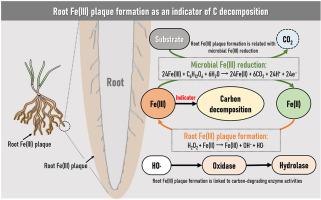Soil Biology and Biochemistry ( IF 9.8 ) Pub Date : 2021-08-30 , DOI: 10.1016/j.soilbio.2021.108403 Yuxiu Liu 1, 2 , Min Luo 3 , Ji Chen 4 , Rongzhong Ye 5 , Ji Tan 1, 2 , Zhifeng Zhai 1, 3 , Yang Yang 1, 2 , Jiafang Huang 1, 2

|
Sea-level rise is projected to influence soil carbon (C) stocks in tidal wetland systems. Although soil C and iron cycling are considered to be related in tidal wetlands, the empirical link between root ferric iron [Fe(III)] plaque formation and C decomposition in response to salinity and flooding is scarcely known. Here, we established mesocosms loaded with soils from a tidal freshwater wetland and subjected to three salinity treatments (fresh control, oligohaline, mesohaline) plus three flooding (i.e., flooding water-level height) treatments. Root Fe(III) plaque abundance, C-degrading enzyme activities, and potential C mineralization rates (CMRs) and microbial Fe(III) reduction rates (FeRRs) were simultaneously quantified. The oligohaline treatment elevated root Fe(III) plaque abundance relative to fresh control, while the mesohaline treatment suppressed it. Owing to high abundance of root Fe(III) plaque, microbial Fe(III) reduction predominated C mineralization in the oligohaline treatment (56 ± 7%). However, the importance of microbial Fe(III) reduction decreased by up to 25 ± 5% in the mesohaline treatment due to inhibition by salinity. The potential CMRs increased by 17% from fresh control to oligohaline treatment, but declined by 27% from fresh control to mesohaline treatment. The potential CMRs were affected by potential FeRRs and C-degrading enzyme activities. The latter two were associated with root Fe(III) plaque abundance. These results together showed that root Fe(III) plaque abundance was linked to potential CMRs in response to salinity. Flooding did not affect root Fe(III) plaque abundance and had much less of an effect on potential CMRs compared to salinity. Altogether, root Fe(III) plaque abundance could be as an indicator of C decomposition rates in tidal freshwater wetland soils in response to salinity and flooding. Future C decomposition prediction models under sea-level rise could embed root Fe(III) plaque abundance as an indicator for integrating plant-microbe-soil interaction into models.
中文翻译:

根铁斑块丰度作为潮汐淡水湿地响应盐度和洪水的碳分解率的指标
预计海平面上升会影响潮汐湿地系统中的土壤碳 (C) 库。尽管土壤碳和铁循环被认为与潮汐湿地有关,但根铁铁 [Fe(III)] 斑块形成与碳分解响应盐度和洪水之间的经验联系鲜为人知。在这里,我们建立了装载有来自潮汐淡水湿地的土壤并经过三种盐度处理(新鲜控制、寡盐、中盐)加上三种洪水(即洪水水位高度)处理的中层世界。同时量化根 Fe(III) 斑块丰度、C 降解酶活性、潜在 C 矿化率 (CMR) 和微生物 Fe(III) 还原率 (FeRR)。相对于新鲜对照,低卤处理提高了根 Fe(III) 斑块的丰度,而中盐酸盐治疗抑制了它。由于高丰度的根 Fe(III) 斑块,微生物 Fe(III) 还原在寡盐处理中占主导地位的 C 矿化 (56 ± 7%)。然而,由于盐度的抑制,微生物 Fe(III) 还原的重要性在中盐处理中降低了 25±5%。从新鲜对照到低卤处理,潜在 CMR 增加了 17%,但从新鲜对照到中盐处理降低了 27%。潜在的 CMR 受潜在 FeRR 和 C 降解酶活性的影响。后两者与根 Fe(III) 斑块丰度有关。这些结果共同表明根 Fe(III) 斑块丰度与响应盐度的潜在 CMR 相关。与盐度相比,洪水不会影响根 Fe(III) 斑块的丰度,并且对潜在 CMR 的影响要小得多。总而言之,根 Fe(III) 斑块丰度可以作为潮汐淡水湿地土壤中 C 分解率的指标,以响应盐度和洪水。未来海平面上升下的 C 分解预测模型可以嵌入根 Fe(III) 斑块丰度作为将植物-微生物-土壤相互作用整合到模型中的指标。


















































 京公网安备 11010802027423号
京公网安备 11010802027423号